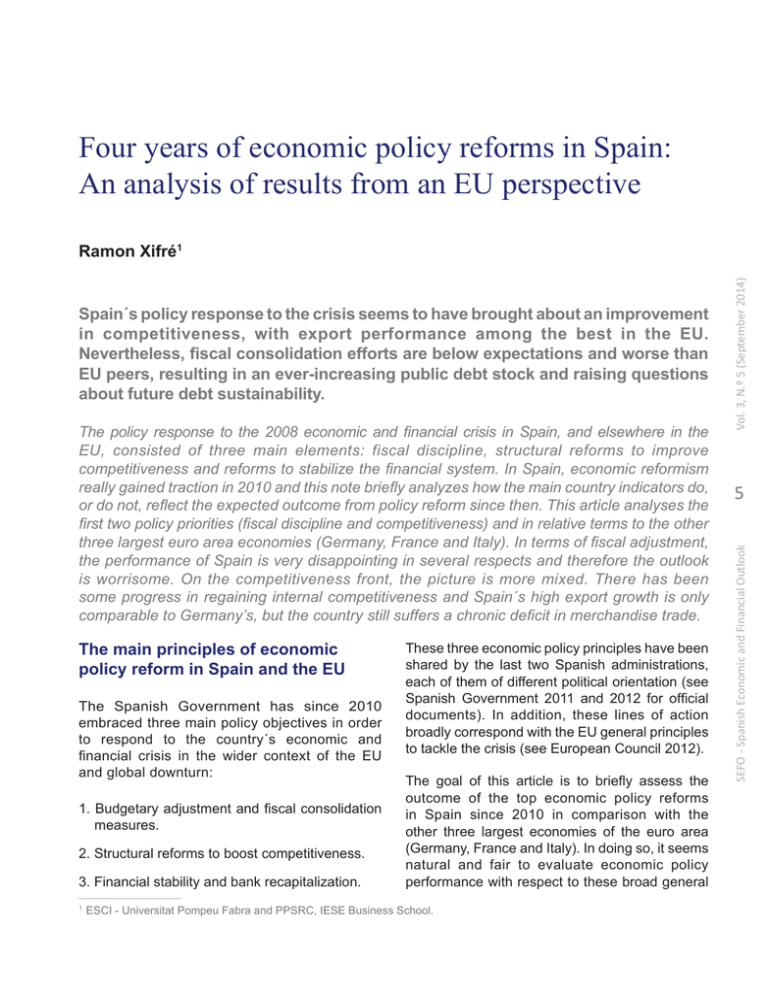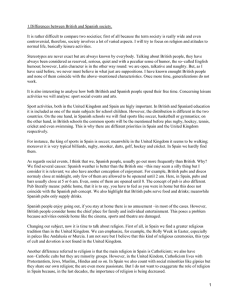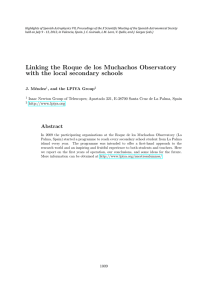Four years of economic policy reforms in Spain
Anuncio

Four years of economic policy reforms in Spain: An analysis of results from an EU perspective The policy response to the 2008 economic and financial crisis in Spain, and elsewhere in the EU, consisted of three main elements: fiscal discipline, structural reforms to improve competitiveness and reforms to stabilize the financial system. In Spain, economic reformism really gained traction in 2010 and this note briefly analyzes how the main country indicators do, or do not, reflect the expected outcome from policy reform since then. This article analyses the first two policy priorities (fiscal discipline and competitiveness) and in relative terms to the other three largest euro area economies (Germany, France and Italy). In terms of fiscal adjustment, the performance of Spain is very disappointing in several respects and therefore the outlook is worrisome. On the competitiveness front, the picture is more mixed. There has been some progress in regaining internal competitiveness and Spain´s high export growth is only comparable to Germany’s, but the country still suffers a chronic deficit in merchandise trade. The main principles of economic policy reform in Spain and the EU The Spanish Government has since 2010 embraced three main policy objectives in order to respond to the country´s economic and financial crisis in the wider context of the EU and global downturn: 1. Budgetary adjustment and fiscal consolidation measures. 2. Structural reforms to boost competitiveness. 3. Financial stability and bank recapitalization. 1 These three economic policy principles have been shared by the last two Spanish administrations, each of them of different political orientation (see Spanish Government 2011 and 2012 for official documents). In addition, these lines of action broadly correspond with the EU general principles to tackle the crisis (see European Council 2012). The goal of this article is to briefly assess the outcome of the top economic policy reforms in Spain since 2010 in comparison with the other three largest economies of the euro area (Germany, France and Italy). In doing so, it seems natural and fair to evaluate economic policy performance with respect to these broad general ESCI - Universitat Pompeu Fabra and PPSRC, IESE Business School. 5 SEFO - Spanish Economic and Financial Outlook Spain´s policy response to the crisis seems to have brought about an improvement in competitiveness, with export performance among the best in the EU. Nevertheless, fiscal consolidation efforts are below expectations and worse than EU peers, resulting in an ever-increasing public debt stock and raising questions about future debt sustainability. Vol. 3, N.º 5 (September 2014) Ramon Xifré1 Ramon Xifré policy priorities. The present article is focused on the first two elements. Fiscal consolidation Vol. 3, N.º 5 (September 2014) Spain´s public finances have deteriorated significantly in the aftermath of the crisis. In terms of flows, the public sector has been running deficits every year since 2008. The Spanish public deficit is contracting over time, but to a much lesser degree than the European Union as a whole (Exhibit 1). In particular, the 20102013 average public deficit was 9.2% of the GDP in Spain, which is more than twice the EU27 figure as a whole (4.5% of the block’s GDP). increase of more than 32 percentage points from the level in 2010. In contrast, the combined debt of the EU27 countries has stabilized and it increased only 7 percentage points during the same period of time (Exhibit 2). The case for stabilization of EU public debt is much stronger if one considers different “core” subsets of EU countries. Firstly, if one excludes from the EU the countries that have received financial support by means of the Economic Adjustment Programmes (EAP) –Greece, Ireland and Portugal– the debt of the 24 remaining EU countries has increased 6.5 percentage points in the period 2010 - 2013. Secondly, if one excludes, in addition to those three EAP countries, the three larger EU countries with the most troubled Exhibit 1 6 Net lending (+) / net borrowing (-) of the General Government (EDP), as % of GDP 4 SEFO - Spanish Economic and Financial Outlook 2 0 -2 -4 -6 -8 -10 -12 2000 2001 2002 2003 2004 2005 2006 2007 2008 2009 2010 2011 2012 2013 EU27 Spain Source: Eurostat. As a result, in terms of stock, Spain´s public debt has been increasing rapidly since 2007, while the debt of the EU as a block appears to be entering into a stabilization phase. Considering only the debt that is included in the Excessive Deficit Procedure (EDP) accounting criterion, Spanish debt peaked at 93.9% of GDP in 2013. This represents an public finances (Spain, Italy and France), the total debt of the remaining set of 21 EU countries has remained remarkably very stable over time at a level of approximately 55% of GDP (see Exhibit 2). The lack of convergence of Spain towards the EU debt stabilization trajectory is not the only Four years of economic policy reforms in Spain: An analysis of results from an EU perspective Exhibit 2 General Government Debt (EDP) in different sets of EU countries, as % of GDP 100 90 80 50 40 30 20 2000 2001 2002 2003 2004 2005 2006 2007 2008 2009 2010 2011 2012 2013 EU27 EU-27 Spain EU27excl. PIG EU-27* EU27 excl. PIGSIF EU-27** Note: *Excluding: Greece, Ireland, Portugal. **Excluding: Greece, Ireland, Portugal, Spain, Italy, France. Source: Eurostat. worrisome element of the budgetary adjustment process in Spain. Another delicate issue that often goes unnoticed is the increasing share of Spanish public liabilities that are excluded from the Excessive Deficit Procedure (EDP) criterion. Following the EDP definition, the debt of a public sector body which is mainly financed by its own sales or that is not performing a government function is not part of the General Government public debt. Exhibit 3 Spanish Public Debt included and excluded in the EDP, and total, as % of GDP 132.1 140 114.6 120 38.2 90.6 100 80 60 71.3 11.9 66.4 65.4 10.8 12.8 71 60.7 59.5 56.9 11.9 13.2 13.7 40 59.4 20 0 55.6 52.6 48.8 46.3 43.2 51.8 12.1 39.7 48 11.7 36.3 54.4 17 78 20.1 16.3 14.2 40.2 54 28.6 61.7 70.5 86 93.9 2000 2001 2002 2003 2004 2005 2006 2007 2008 2009 2010 2011 2012 2013 EDP Source: Bank of Spain. Non-EDP Total 7 SEFO - Spanish Economic and Financial Outlook 60 Vol. 3, N.º 5 (September 2014) 70 Vol. 3, N.º 5 (September 2014) Ramon Xifré SEFO - Spanish Economic and Financial Outlook 8 The lack of convergence of Spain towards the EU debt stabilization trajectory is not the only worrisome element of the budgetary adjustment process in Spain. Another delicate issue that often goes unnoticed is the increasing share of Spanish public liabilities that are excluded from the Excessive Deficit Procedure (EDP) criterion. The share of the non-EDP public debt in Spain used to mildly oscillate around 12% of GDP up to 2007 (Exhibit 3). Since 2008, however, this component of public liabilities has been growing and it peaked at 38.2% in 2013. This is troubling because it might be reflecting that the different levels of government in Spain (central, regional, local) are transferring debt towards public bodies and agencies that fall out of the EDP perimeter but that, based on historical standards, should be counted as part of the EDP debt. Competitiveness and structural reforms Internal competitiveness The main headline indicator of internal (or pricecost) competitiveness, the real effective exchange rate (REER) deflated by the unit labour cost (ULC), has improved significantly in Spain between 2008 and 2012 (the latest available data). Exhibit 4 represents this measure for each of the four largest euro area economies, compared with the rest of the euro area countries and in relative terms to 2000. As it is well known, an increase in the REER implies that domestic products become more expensive and, therefore, a competitiveness loss for the country with respect to reference countries. The price-cost competitiveness conditions dramatically deteriorated in Spain and Italy between 2000 and 2008. Both countries experienced an accumulated 25% competitiveness loss (i.e. Exhibit 4 Real Effective Exchange Rate vs. the rest of the euro area, deflated by the nominal unit wage cost in manufacturing (index 2000 = 1) 1.4 1.3 1.2 1.1 1.0 0.9 0.8 0.7 0.6 2000 2001 2002 2003 2004 2005 2006 2007 2008 2009 2010 2011 2012 Germany Source: European Commission (Ecfin). Spain France Italy A substantial part of the competitiveness correction in Spain was caused by the massive labour shedding that occurred in the country. The Spanish unemployment rate increased from 8% in the beginning of 2008 to 26% by the end of 2013 (see Laborda and Fernández 2014 for an overview of the main recent economic developments and perspectives in Spain). External competitiveness Spanish exports of goods and services have grown since 2000, and also since 2009, to a rate comparable only to Germany´s within the group of the four largest economies in the EU. Measured in current euros, Spanish exports have almost doubled during this period of 14 years. This applies both to total exports (including services and, therefore, tourists’ expenditures in Spain) and also to merchandise exports alone (Exhibit 5), suggesting that there is a healthy and expanding tradable sector in Spain. This observation is relevant because the tradable sector of an economy is generally considered to be superior, Measured in current euros, Spanish exports have almost doubled over the last 14 years. This applies both to total exports (including services and, therefore, tourists’ expenditures in Spain) and also to merchandise exports alone, suggesting that there is a healthy and expanding tradable sector in Spain. in terms of competitiveness, to the non-tradable sector as it faces tougher competition coming from overseas firms. Exhibit 5 Exports of goods, current prices (index 2000 = 1) 2.25 2 1.75 1.5 1.25 1 0.75 2000 2001 2002 2003 2004 2005 2006 2007 2008 2009 2010 2011 2012 2013 Germany Source: Eurostat. Spain France Italy 9 SEFO - Spanish Economic and Financial Outlook REER appreciation) in this period due to lower productivity gains and higher wage and margin increases than the rest of the euro area. However, both countries have had opposite trajectories since then. While Italy kept losing competitiveness and reached a record-high REER appreciation of more than 30% in 2012, Spain has recovered more than two thirds of the competitiveness loss and by 2012, the REER appreciation was less than 8%. Vol. 3, N.º 5 (September 2014) Four years of economic policy reforms in Spain: An analysis of results from an EU perspective Ramon Xifré Vol. 3, N.º 5 (September 2014) Despite this successful export trajectory, three caveats must be mentioned regarding external competitiveness in Spanish. SEFO - Spanish Economic and Financial Outlook 10 Firstly, following the recent work of Myro (2013), the internationalization of the Spanish economy suffers from three types of structural weaknesses: a) the production in Spain is tilted towards low technological intensity manufacturing; b) the business structure is disproportionally dominated by small-sized companies; and, c) the geographical structure of exports, and international activities as a whole, is still very concentrated in EU destinations. Secondly, another important weakness of Spain´s external competitiveness is the chronic merchandise trade deficit, which is recurrently compensated for by services surpluses. Exhibits 6 and 7 represent the net exports (exports minus imports) of goods, services and total as a percentage of GDP for Spain and Germany, respectively. Exhibit 6 shows that, although the Spanish total trade balance has improved notably since 2009, the goods trade balance has been systematically in deficit. This structural pattern is exactly the opposite of the German one (Exhibit 7). Thirdly, the real effective exchange rate (REER), deflated by the prices of exports of goods and services, has steadily increased in Italy and Spain between 2000 and 2012 leading to a 10% appreciation. In contrast, the prices of exports of French, and especially German, products and services have decreased during this period (Exhibit 8). The interpretation of this fact is quite open and, in any case, this trend is better accounted for when compared with data represented in Exhibits 4 and 5. When comparing both REERs, the one adjusted by the nominal unit wage cost in manufacturing and the one deflated by the prices of exports, the idea that emerges is that the internal cost compression that has taken place in Spain has not been transmitted to the goods and services sold in foreign markets. When comparing the price of exports and export performance, it is noteworthy that despite the fact that both Italian and Spanish products have apparently become more expensive over time, Spanish exports have grown twice as much as the Italian ones in the period 2000 - 2013. Exhibit 6 Trade balance (net exports) of Spain by type of trade, as % of GDP 10 8 6 4 2 2.4 0 0.8 -2 -4 -3.1 -2.5 -2.1 -4 -6 -8 -10 -1.9 -2.3 -5.3 -6.4 -6.7 -2.2 -1.1 -5.8 2000 2001 2002 2003 2004 2005 2006 2007 2008 2009 2010 2011 2012 2013 Goods Source: Eurostat. Services Total Four years of economic policy reforms in Spain: An analysis of results from an EU perspective Exhibit 7 Trade balance (net exports) of Germany by type of trade, as % of GDP 10 8 4.5 2 3.9 5.1 5.2 5.6 6.3 4.9 5.6 5.2 5.9 6.2 2 0 0.3 -2 -4 -6 -8 -10 2000 2001 2002 2003 2004 2005 2006 2007 2008 2009 2010 2011 2012 2013 Source: Eurostat. Goods Services The combination of these two interpretations may suggest that some “quality upgrading” is occurring within Spanish export products. The internal wage costs of the Spanish economy are declining over time since 2008 but the price of the products the country ships to the rest of Total the world are not, in relative terms to the rest of euro area countries. A possible reason is that Spanish goods and services are (perceived to be) offering a higher value added to foreign markets, by means of implementing several arguments of vertical differentiation: better product quality, Exhibit 8 Real Effective Exchange Rate vs. the rest of the euro area – Price deflator, exports of goods and services (index 2000 = 1) 1.15 1.10 1.05 1.00 0.95 0.90 0.85 2000 2001 2002 2003 2004 2005 2006 2007 2008 2009 2010 2011 2012 Germany Source: European Commission (Ecfin). Spain France Italy Vol. 3, N.º 5 (September 2014) 7 4 11 SEFO - Spanish Economic and Financial Outlook 6 Vol. 3, N.º 5 (September 2014) Ramon Xifré SEFO - Spanish Economic and Financial Outlook 12 innovative design, larger portfolio of varieties, more comprehensive post-sale service, etc. The relevance of “quality upgrading” has long been recognized in literature as a high-powered explanatory factor of trade and competitiveness (Schott, 2004). However the evidence for Spain is still scarce and partial (Cuadras et al., 2009 and Gordo and Tello, 2011 are one of the few works that calculate some estimates), which makes it difficult to come up with a solid conclusion on this matter. The potential importance of this trend surely demands further work and analysis. The internal wage costs of the Spanish economy are declining over time since 2008 but the price of the products the country ships to the rest of the world are not, in relative terms to the rest of euro area countries. A possible reason is that Spanish goods and services are (perceived to be) offering a higher value added to foreign markets. Financial stability and reform In terms of financial system reform, restructuring and recapitalization, the available evidence suggests that Spain has undergone a deeper and swifter process relative to the rest of the EU countries. This issue falls beyond the scope of the present note and recent monographic analyses can be found in Carbó Valverde and Rodríguez Fernández (2014a and 2014b). Conclusions The top policy priorities in Spain and elsewhere to overcome the crisis have been mainly three: fiscal consolidation, structural reforms to improve competitiveness and financial system reforms and recapitalization. This paper focuses on the first two and analyzes how the main headline indicators reflect the expected outcome from policy reform in relative terms to the other three largest euro area economies (Germany, France and Italy). As regards public finances, the performance of the Spanish economy has been rather poor. Not only is Spain´s public debt still increasing and likely to represent, in the near future, double that of the “core” EU countries, which has been remarkably stable at 55% of GDP for the last 15 years, but also very worrying is the fact that public liabilities that are not counted under the Excessive Deficit Procedure definition have tripled in comparison with pre-crisis levels and are now approaching 40% of GDP. On the competitiveness front, the picture is more mixed. On the one hand, since 2008 there has been a significant and idiosyncratic improvement in ULCs in Spain as a result of massive labour shedding. Furthermore, Spanish exports are the only ones of the large euro area countries that grow at the pace of those of Germany. Finally, on an ambivalent note: the prices of the goods and services sold by Spanish companies abroad are increasing over time in relative terms to the rest of euro area countries. References Carbó, S., and Rodríguez, F. (2014a), “Spanish banks: Boosting Solvency and performance ahead of the comprehensive assessment”, SEFO, vol. 3, no. 2. — “Has bank restructuring in Spain and Europe paid off?”, SEFO, vol. 3, no. 3. Cuadras, X.; Puig, J., and Xifré, R. (2009), Competitividad y evolución de la balanza por cuenta corriente, Consejo Económico y Social. European Council (2012), Towards a Genuine Economic and Monetary Union, EUCO 120/12. Gordo, E., and Tello, P. (2011), “Diversificación, precios y calidad de las exportaciones españolas: una comparación a nivel europeo”, Cuadernos Económicos, ICE, no. 82. Four years of economic policy reforms in Spain: An analysis of results from an EU perspective Laborda, A., and Fernández, M.J. (2014), “Spain’s economic recovery is gaining strength, but remains sluggish”, SEFO, vol. 3, no. 2. Spanish Government (2011), 2011 National Reform Programme, (http://ec.europa.eu/europe2020/pdf/nrp/ nrp_spain_es.pdf). — (2012), “Un año de Gobierrno. Un año de reformas”, (http://www.lamoncloa.gob.es/documents/ reformasgobierno.pdf). 13 SEFO - Spanish Economic and Financial Outlook Schott, P.K. (2004), “Across-product versus withinproduct specialization in International Trade”, The Quarterly Journal of Economics, vol. 119. Vol. 3, N.º 5 (September 2014) Myro, R. (2013), “La política de internacionalización de la empresa española”, Economía Industrial, no 387: pp. 119-130.


